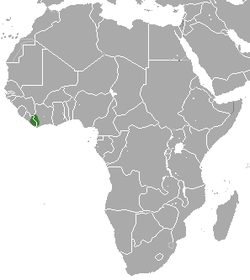| Liberian mongoose | |
|---|---|
| Scientific classification | |
| Kingdom: | Animalia |
| Phylum: | Chordata |
| Class: | Mammalia |
| Order: | Carnivora |
| Family: | Herpestidae |
| Genus: | Liberiictis Hayman, 1958 |
| Species: | L. kuhni [2] |
| Binomial name | |
| Liberiictis kuhni [2] Hayman, 1958 | |
 | |
| Range of the Liberian mongoose | |
The Liberian mongoose (Liberiictis kuhni) is a mongoose species native to Liberia and Ivory Coast. [1] It is the only member of the genus Liberiictis. [3] Phylogenetic analysis shows it is closely related to other small, social mongooses and that the banded mongoose is its closest relative. [4]
